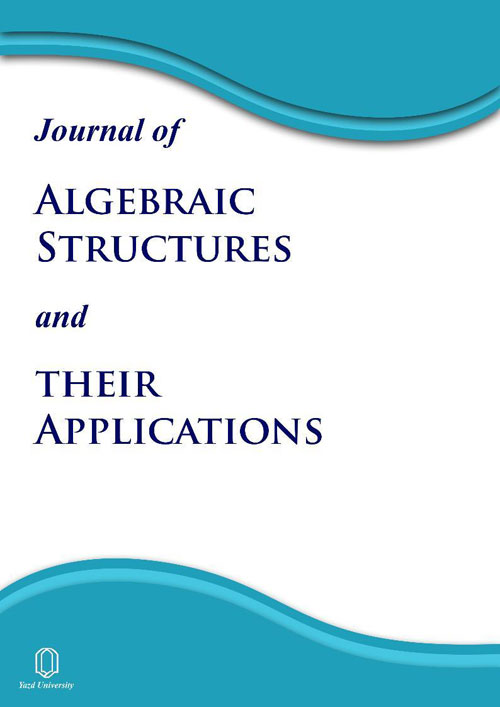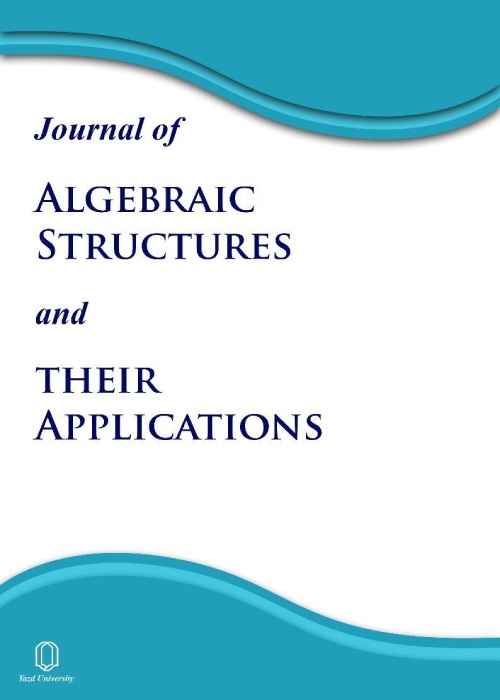فهرست مطالب

Journal of Algebraic Structures and Their Applications
Volume:6 Issue: 1, Winter-Spring 2019
- تاریخ انتشار: 1397/12/10
- تعداد عناوین: 12
-
-
Pages 1-21The paper is devoted to concern a relationship between rough set theory and universal algebra. Notions of lower and upper rough approximations on an algebraic structure induced by an ideal are introduced and some of their properties are studied. Also, notions of rough subalgebras and rough ideals with respect to an ideal of an algebraic structure, which is an extended notion of subalgebras and ideals in an algebraic structure, are introduced and investigated.Keywords: rough set, approximation, universal algebra, subalgebra, rough subalgebra, ideal, rough ideal
-
Pages 23-33A category $mathbf{C}$ is called Cartesian closed provided that it has finite products and for each$mathbf{C}$-object $A$ the functor $(Atimes -): Ara A$ has a right adjoint. It is well known that the category $mathbf{TopFuzz}$ of all topological fuzzes is both complete and cocomplete, but it is not Cartesian closed. In this paper, we introduce some Cartesian closed subcategories of this category.Keywords: Topological fuzz, Exponentiable object, Cartesian closed category
-
Pages 35-45In this paper, we employ the concept of the Generalized Discrete Fourier Transform, which in turn relies on the Hasse derivative of polynomials, to give a general construction of Reed-Solomon codes over Galois fields of characteristic not necessarily co-prime with the length of the code. The constructed linear codes enjoy nice algebraic properties just as the classic one.Keywords: Generalized Discrete Fourier Transform, Hasse Derivatives, Linear Codes, Reed-Solomon Codes
-
Pages 49-56In this paper, we introduce a suitable generalization of Cayley graphs that is defined over polygroups (GCP-graph) and give some examples and properties. Then, we mention a generalization of NEPS that contains some known graph operations and apply to GCP-graphs. Finally, we prove that the product of GCP-graphs is again a GCP-graph.Keywords: Simple graph, Caylay graph, polygroup, GCP-graph, graph product
-
Pages 57-65In this paper, groups with trivial intersection between Frattini and derived subgroups are considered. First, some structural properties of these groups are given in an important special case. Then, some family invariants of each $n$-isoclinism family of such groups are stated. In particular, an explicit bound for the order of each center factor group in terms of the order of its derived subgroup is also provided.Keywords: Frattini subgroup, Soluble group, Sylow subgroup
-
Pages 67-84In this article, we shall study the structure of$(a+bu)-$constacyclic codes of arbitrary length over the ring$R=F_{q}+uF_{q}+cdots +u^{e-1}F_{q}$, where $u^{e}=0$, $q$ is apower of a prime number $p$ and $a,b$ are non-zero elements of$F_{q}$. Also we shall find a minimal spanning set for these codes. %, and completely determine the structure of these codes.For a constacyclic code $C$ we shall determine its minimum Hammingdistance with some properties of $Tor(C)$ as an $a-$constacycliccode over $F_{q}$.Keywords: Linear code, constacyclic code, minimal spanning set, minimum Hamming distance
-
Pages 85-99In this paper, we propose a new certificateless identification scheme based on isogenies between elliptic curves that is a candidate for quantum-resistant problems. The proposed scheme has the batch verification property which allows verifying more than one identity by executing only a single challenge-response protocol.Keywords: Certificateless Identification Scheme, Elliptic Curves, Isogeny, Cryptography, Pairing
-
Pages 101-104Let $R$ be a commutative Noetherian ring with non-zero identity, $mathfrak{a}$ an ideal of $R$, $M$ a finitely generated $R$--module, and $a_1, ldots, a_n$ an $mathfrak{a}$--filter regular $M$--sequence. The formulabegin{align*}operatorname{H}^i_mathfrak{a}(M)congleft{begin{array}{lll}operatorname{H}^i_{(a_1, ldots, a_n)}(M) & text{for all} mathrm{i< n},\operatorname{H}^{i- n}_mathfrak{a}(operatorname{H}^n_{(a_1, ldots, a_n)}(M)) & text{for all} mathrm{igeq n},end{array}right.end{align*}is known as Nagel-Schenzel formula and is a useful result to express the local cohomology modules in terms of filter regular sequences. In this paper, we provide an elementary proof to this formula.Keywords: Filter regular sequences, local cohomology modules, Nagel-Schenzel formula
-
Pages 103-114
In this paper, we define a generalized of clean of Krasner hyperrings for general hyperrings based on the notation of nilpotent elements of a general hyperring R, named nil clean hyperring. We examine characterization of this kind of hyperrings and finally, we obtain some relations of nil clean general hyperrings with other hyperrings.
Keywords: Hyperring, General hyperring, Nil clean general hyperring -
Pages 115-125
Let $R$ be a prime ring with $U$ the Utumi quotient ring and $Q$ be the Martindale quotient ring of $R$, respectively. Let $d$ be a derivation of $R$ and $m,n$ be fixed positive integers. In this paper, we study the case when one of the following holds:$(i)$~ $d(x)circ_n d(y)$=$xcirc _m y$ $(ii)$~$d(x)circ_m d(y)$=$(d(xcirc y))^n$ for all $x,y$ in some appropriate subset of $R$. We also examine the case where $R$ is a semiprime ring. Finally, as an application we apply our result to the continuous derivations on Banach algebras.
*The formula is not displayed correctly!Keywords: Prime, semiprime rings, Derivations, Martindale ring of quotients, Banach algebras, Radical -
Pages 127-138
An $(a,b)$ elementary trapping set (ETS), where $a$ and $b$ denote the size and the number of unsatisfied check nodes in the ETS, influences the performance of low-density parity-check (LDPC) codes. The smallest size of an ETS in LDPC codes with column weight 3 and girth 6 is 4. In this paper, we concentrate on a well-known algebraic-based construction of girth-6 QC-LDPC codes based on powers of a primitive element in a finite field $mathbb{F}_q$. For this structure, we provide the sufficient conditions to obtain $3times n$ submatrices of an exponent matrix in constructing girth-6 QC-LDPC codes whose ETSs have the size of at least 5. For structures on finite field $mathbb{F}_q$, where $q$ is a power of 2, all non-isomorphic $3times n$ submatrices of the exponent matrix which yield QC-LDPC codes free of small ETSs are presented.
*The formula is not displayed correctly!Keywords: QC-LDPC codes, girth, Tanner graph, elementary trapping set -
Pages 139-148
In 2012, Guo and Gong proved that if G is a finite nonabelian group with Φ(G)=1, then |G:Z(G)|<|G′||U(G)|, in which U(G) is the nilpotent residual of G. We show that the assumption of finiteness of the group can be omitted. Moreover, we investigate converse of Schur and Baer's theorems for groups that can be seen as generalizations of groups with trivial Frattini subgroups and state some properties of n-isoclinism families of these groups.
*The formula is not displayed correctly!Keywords: Baer's theorem, Frattini subgroup, Upper, lower central series


